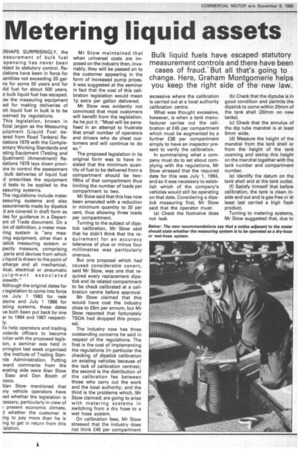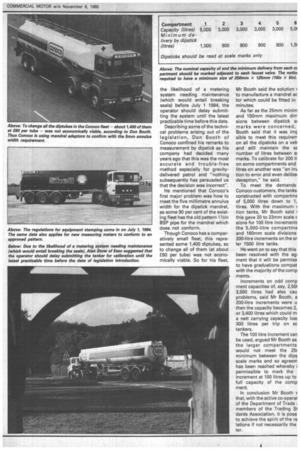Metering liquid assets
Page 60

Page 61

If you've noticed an error in this article please click here to report it so we can fix it.
ERHAPS SURPRISINGLY, the easurement of bulk fuel spensing has never been ibject to statutory control. ReJlations have been in force for Jantities not exceeding 20 gains for some 50 years and for ilid fuel for about 500 years, lt bulk liquid fuel has escaped. Dw the measuring equipment ;ed for making deliveries of ich liquid fuel in bulk is to be werned by regulations.
This legislation, known in ficial jargon as the Measuring luipment (Liquid Fuel deered from Road Tankers) Reilations 1979 with the Compleentary Working Standards and !sting Equipment (Testing and ijustment) (Amendment) Reilations 1979 lays down provi)ns to control the assessment bulk deliveries of liquid fuel d prescribes the equipment d tests to be applied to the aasuring systems.
The regulations include meter aasuring systems and also aasurements made by dipstick d are covered in draft form as tes for guidance in a Departant of Trade document. On a mt of definition, a meter mearing system is "any mearing equipment, other than a )stick measuring system or pacity measure, comprising parts and devices from which 3 liquid is drawn to the point of ;charge and all mechanical, tical, electrical or pneumatic iuipment associated arewith."
4Ithough the original dates for • i legislation to come into force re July 1 1983 for new stems and July 1 1986 for isting systems, these dates ve both been put back by one ar to 1984 and 1987 respectily.
lo help operators and trading indards officers to become niliar with the proposed legision, a seminar was held in wington last week organised the Institute of Trading Stanrds Administration. Putting ward comments from the erating side were Alan Stow Esso and Don Booth of noco.
\Ian Stow mentioned that iny vehicle operators have ced whether the legislation is essary, particularly in view of present economic climate, whether the customer is ing to pay more than he is ing to get in return from this islation. Mr Stow maintained that when universal costs are imposed on the industry then, invariably, they will be passed on to the customer appearing in the form of increased pump prices. It was suggested at the seminar in fact that the cost of this calibration legislation would mean 1p extra per gallon delivered.
Mr Stow was evidently not convinced that most customers will benefit from the legislation. As he put it: "Most will be penalised in an attempt to frustrate that small number of operators and drivers who do cheat customers and will continue to do so."
The proposed legislation in its original form was to have insisted that the minimum quantity of fuel to be delivered from a compartment should be twofifths of that compartment thus limiting the number of loads per compartment to two.
Mr Stow said that this has now been amended with a reduction in minimum quantity to 30 per cent, thus allowing three loads per compartment.
Turning to the subject of dipstick calibration, Mr Stow said that he didn't think that the requirement for an accuracy tolerance of plus or minus four millimetres was particularly onerous.
But one proposal which had caused considerable conern, said Mr Stow, was one that required every replacement dipstick and its related compartment to be check calibrated at a calibration centre before approval.
Mr Stow claimed that this would have cost the industry close to £6m per annum, but Mr Stow reported that fortunately TSOA had dropped this proposal.
The industry now has three outstanding concerns he said in respect of the regulations. The first is the cost of implementing the regulations (in particular the checking of dipstick calibration on existing vehicles because of the lack of calibration centres); the second is the distribution of the calibration fee between those who carry out the work and the local authority; and the third is the problems which, Mr Stow claimed; are going to arise with metering systems in switching from a dry hose to a wet hose system.
On calibration fees, Mr Stow stressed that the industry does not think £45 per compartment excessive where the calibration is carried out at a local authority calibration centre.
What was thought excessive, however, is when a tank manufacturer carries out the calibration at £45 per compartment which must be augmented by a further £38 per compartment simply to have an inspector present to verify the calibration.
In summarising what a company must do to set about complying with the regulations, Mr Stow stressed that the required date for this was July 1, 1984, and so it was necessary to establish which of the company's vehicles would still be operating on that date. Considering a dipstick measuring first, Mr Stow said that the operator must: (a) Check the footvalve does not leak. (b) Check that the diptube is in good condition and permits the dipstick to come within 25mm of the tank shell (20mm on new tanks).
(c) Check that the annulus of the dip tube mandrel is at least 5mm wide.
(d) Measure the height of the mandrel from the tank shell or from the height of the tank coaming and stamp this height on the mandrel together with the tank number and compartment number.
(e) Identify the datum on the tank shell and at the tank outlet.
(f) Satisfy himself that before calibration, the tank is clean inside and out and is gas-free or at least last carried a high flash product.
Turning to metering systems, Mr Stow suggested that, due to the likelihood of a metering system needing maintenance (which would entail breaking seals) before July 1 1984, the operator should delay submitting the system until the latest practicable time before this date.
Describing some of the technical problems arising out of the legislation, Don Booth of Conoco confined his remarks to measurement by dipstick as his company had decided many years ago that this was the most accurate and trouble-free method especially for gravitydelivered petrol and "nothing subsequently has persuaded us that the decision was incorrect".
He mentioned that Conoco's first major problem was how to meet the five millimetre annulus width for the dipstick mandrel, as some 90 per cent of the existing fleet has the old pattern 11/2in BSP pipe for the mandrel which does not conform.
Though Conoco has a comparatively small fleet, this represented some 1,400 diptubes, so to change all of them {at about £60 per tube) was not economically viable. So for his fleet, Mr Booth said the solution to manufacture a mandrel ac tor which could be fitted in minutes.
As far as the 25mm minim and 150mm maximum dinsions between dipstick sc marks were concerned, Booth said that it was imr sible to meet this requirer on all the dipsticks on a veh and still maintain the SE number of litres between Sr marks. To calibrate for 200 Ii on some compartments and litres on another was "an in lion to error and even clelibei deception," he said.
To meet the demands Conoco customers, the tanks constructed with corn partmE of 5,000 litres down to 1, litres. With the maximum tion tanks, Mr Booth said 1 this gave 20 to 23mm scale c sions for 100 litre increments the 5,000-litre compartme and 160mm scale divisions 200-litre increments on the sr. ler 1500 litre tanks.
He went on to say that this been resolved with the agi ment that it will be permiss to have graduations compat with the majority of the comp men ts.
Increments on odd comp merit capacities of, say, 2,50( 3,500 litres had also cau problems, said Mr Booth, a 200-litre increments were u then the capacity becomes 2, or 3,400 litres which could m a nett carrying capacity los$. 300 litres per trip on sc tankers.
The 100 litre increment can be used, argued Mr Booth as, the larger compartments would not meet the 25r minimum between the dips scale marks and so agreem has been reached whereby i permissible to mark the increment at 100 litres up to full capacity of the comp ment.
In conclusion Mr Booth that, with the active co-operal of the Department of Trade i members of the Trading Si dards Association, it is poss to achieve the spirit of the re lations if not necessarily the ter.




















































































































